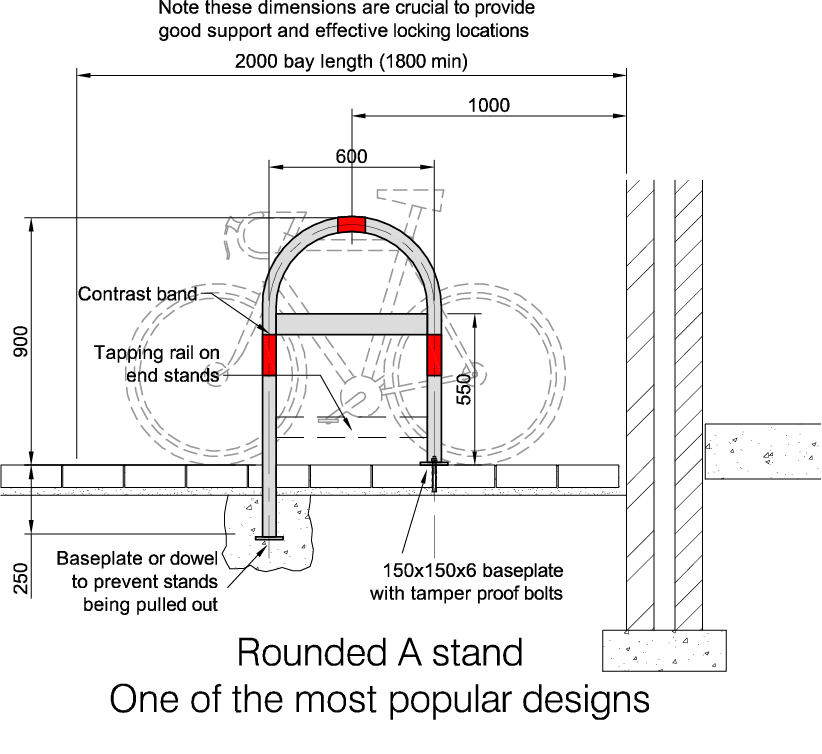The wearing surface of all cycelways and pathways shall be concrete. A key design aspect is the width of the path. bike path design standards.
Bike Path Design Standards, People riding bikes require more light in order to detect hazards rough surfaces. They are grouped into themes including nation-specific guidance. Summary of Design Principles for Good Bicycle Infrastructure 7 May 2020 21 Principle Rationale Source Lighting Bicycle Paths or shared paths that carry substantial numbers of cyclists between dawn and dusk should be lit in accordance with lighting level P2 or higher.
 Bike Parking Standards Parking Design Bike Parking Design Bicycle Parking From pinterest.com
Bike Parking Standards Parking Design Bike Parking Design Bicycle Parking From pinterest.com
VicRoads Cycle Notes 21 external link and Technical Note 133 Guidance on the widths of shared paths and separated bicycle paths external link provides guidance on the capacity of paths including when it is preferable to use dual exclusive paths instead. Landings at regular intervals every 100m for resting and a wider bike path to accommodate weaving. The designer shall ensure that design details for all cycleways and pathways comply with the requirements detailed in Councils relevant standard drawing.
18-25 m one-way 30-36 m two-way 15 m one-way 24 m two-way 3.
People riding bikes require more light in order to detect hazards rough surfaces. Bicycle lanes are one-way facilities and carry bicycle traffic in the same direction as adjacent motor vehicle traffic. The two most important considerations that should be made when designing a bicycle path are safety and accessibility. The location and design of paths may be influenced by a range of aspects that need to be considered and facilities that need to. Monday 5 June 2017. These documents are for designers and decision-makers planning and delivering walking and cycling infrastructure.
Another Article :

Paths for Walking and Cycling. The wearing surface of all cycelways and pathways shall be concrete. Detailed guidance is provided on path location alignment width clearances crossfall drainage and sight distance requirements. In particular bikeway design guidance for Class I Bikeways bike paths in Chapters 200 and 1000 for vertical clearance design speed stopping sight distance drainage landscaping etc may be used as appropriate for the Class IV Bikeway design. Identify hills on cycling route maps. Bicycle Tyre Sizing And Dimension Standards Bikegremlin Bicycle Tires Tyre Size Bike Tire.

Design the shared-use path to encourage bicyclists to operate at speeds compatible with other users. Raised priority crossings for pedestrian and cycle paths PDF 226 MB Selection and design of cycle tracks PDF 236 MB Speed management on shared paths PDF 845 KB TN197 Provision of shade along paths PDF 220 KB Treatment options to improve safety of pedestrians bicycle riders and other path users at driveways PDF 443 MB. Where the designer wants to propose an alternative treatment they shall seek and obtain separate prior approval. Bicycle Design Standards B-4 January 2012 Class 1 Bike Path. A length of 18 m is to be used for standard design bike. 6 Lane Node With Brt In Dedicated Lanes Streetscape Design Urban Design Graphics Landscape Design.

The Guide provides advice on the design of paths for safe and efficient walking and cycling both within and outside the road corridor including pedestrian paths bicycle paths or cycle tracks shared paths and separated paths. A length of 18 m is to be used for standard design bike. Monday 5 June 2017. ÂBased on Interim Approval issued by FHWA in April 2011 contrasting green color pavement may be used in marked bike lanes and in extensions of bike lanes through intersections and other traffic conflict areas such as merge areas where turning vehicles must. The conditions of the existing roadway needs to be assessed specifically intersections and the merging of bike paths with the main roadway. One Way Protected Cycle Tracks Nacto Street Design Design Track Bus.

Sign a flatter alternate route if possible. The NACTO Urban Bikeway Design Guide is based on the experience of the best cycling cities in the world. On one-way streets bicycle lanes should typically be placed on the right side of the street. These types of facilities are explained in more detail in this cycling section of the AT Code Of Practice ATCOP. No national standards or guidelines dictate RWT facility design. Rollers Bike Pump Track Kids Bike Track Skateboard Ramps.

Road controlling authorities may also have their own guidance in relation to design requirements in their local area. Rail-with-Trail Rail with trail RWT describes any shared use path or trail located on or directly adjacent to an active railroad corridor. They are grouped into themes including nation-specific guidance. If you are designing an off-road bikeway on State Aid projects the shared-use trail or path standards shown in State Aid Rule 88209995 Minimum Bicycle Path Standards must be met. On one-way streets bicycle lanes should typically be placed on the right side of the street. Bike Parking Standards Parking Design Bike Parking Design Bicycle Parking.

If the bike path profile is not consistent with the roadway profile provide a separate profile for the bike path. Austroads has published an updated edition of the Guide to Road Design Part 6A. Bicycle Design Standards B-4 January 2012 Class 1 Bike Path. Paths for Walking and Cycling. These types of facilities are explained in more detail in this cycling section of the AT Code Of Practice ATCOP. Landscape And Aesthetics Design Manual Bicycle And Pedestrian Access Pedestrian Environmental Psychology Sustainable Community.

Paths for Walking and Cycling. 18-25 m one-way 30-36 m two-way 15 m one-way 24 m two-way 3. If you are designing an off-road bikeway on State Aid projects the shared-use trail or path standards shown in State Aid Rule 88209995 Minimum Bicycle Path Standards must be met. The NACTO Urban Bikeway Design Guide is based on the experience of the best cycling cities in the world. In particular bikeway design guidance for Class I Bikeways bike paths in Chapters 200 and 1000 for vertical clearance design speed stopping sight distance drainage landscaping etc may be used as appropriate for the Class IV Bikeway design. Bike Parking Standards Parking Design Bike Parking Design Bicycle Parking.

If you are designing an off-road bikeway on State Aid projects the shared-use trail or path standards shown in State Aid Rule 88209995 Minimum Bicycle Path Standards must be met. If you are designing an off-road bikeway on State Aid projects the shared-use trail or path standards shown in State Aid Rule 88209995 Minimum Bicycle Path Standards must be met. Austroads has published an updated edition of the Guide to Road Design Part 6A. The wearing surface of all cycelways and pathways shall be concrete. The Guide provides advice on the design of paths for safe and efficient walking and cycling both within and outside the road corridor including pedestrian paths bicycle paths or cycle tracks shared paths and separated paths. Image Result For Bus Drop Off Design Standards Bus Stop Design Bus Stop Landscape Architecture Design.

No national standards or guidelines dictate RWT facility design. ÂBased on Interim Approval issued by FHWA in April 2011 contrasting green color pavement may be used in marked bike lanes and in extensions of bike lanes through intersections and other traffic conflict areas such as merge areas where turning vehicles must. Type on curbed roadways with a design speed 45 mph. Bike Path Walkway 46-52 m 40 m 2. Where used the barrier should be a minimum of 11 m 42 inches high to prevent bicyclists from toppling over it. Landscape Gardening Design Landscape Architectural Graphic Standards Pdf Download Landscape Architecture Design Landscape Architecture Drawing Landscape Design.

These types of facilities are explained in more detail in this cycling section of the AT Code Of Practice ATCOP. The conditions of the existing roadway needs to be assessed specifically intersections and the merging of bike paths with the main roadway. 13 Cycling Infrastructure Design 131 Introduction 1311 Cycling Facilty Types There are many different types of provisions which can assist cyclists directly or indirectly as shown in. Detailed guidance is provided on path location alignment width clearances crossfall drainage and sight distance requirements. Design the shared-use path to encourage bicyclists to operate at speeds compatible with other users. The Entire Road Will Be Turned Into A Bi Directional Cycle Path With Pedestrian Paths On Either End And Fl In 2020 Urban Architecture Urban Landscape Urban Design Plan.

If the bike path profile is not consistent with the roadway profile provide a separate profile for the bike path. Minimum and Maximum Grade. Consider mitigation measures for people riding downhill including higher design speeds improved sightlines and other safety measures. A length of 18 m is to be used for standard design bike. Higher speeds are discouraged in a mixed-use setting. Vassar Street Cycletrack Street Bike Path Street View.

The Guide provides advice on the design of paths for safe and efficient walking and cycling both within and outside the road corridor including pedestrian paths bicycle paths or cycle tracks shared paths and separated paths. Standard cycle types in single lane facilities or where a high proportion of non-standard cycles may be present to allow passing each other. Section 173 Off-Street Bicycle Paths Design Requirements. Landings at regular intervals every 100m for resting and a wider bike path to accommodate weaving. Austroads has published an updated edition of the Guide to Road Design Part 6A. Sonny Tomic On Twitter Traffic Signal Bike Lane Pedestrian Street.

A profile of the proposed bike path construction shall be included in the construction plans or site plan. Weve pulled together a collection of high-quality UK design guidance for walking and cycling infrastructure. Type on curbed roadways with a design speed 45 mph. A length of 18 m is to be used for standard design bike. Where the designer wants to propose an alternative treatment they shall seek and obtain separate prior approval. Buffered Bike Lanes A Much Better Fit For Dexter Fremont Bridge Bike Lane Best.

When design elements are not covered by State Aid Rules State Aid recommends that the designer follow the MnDOT Bikeway Facility Design Manual and its associated website updates. ÂBased on Interim Approval issued by FHWA in April 2011 contrasting green color pavement may be used in marked bike lanes and in extensions of bike lanes through intersections and other traffic conflict areas such as merge areas where turning vehicles must. These types of facilities are explained in more detail in this cycling section of the AT Code Of Practice ATCOP. Consider mitigation measures for people riding downhill including higher design speeds improved sightlines and other safety measures. The wearing surface of all cycelways and pathways shall be concrete. Pin On Designxtudio Empowering Ideas.

Where the designer wants to propose an alternative treatment they shall seek and obtain separate prior approval. A bicycle lane on the left side of the street can be. Bicycle Design Standards B-4 January 2012 Class 1 Bike Path. These documents are for designers and decision-makers planning and delivering walking and cycling infrastructure. The two most important considerations that should be made when designing a bicycle path are safety and accessibility. West West Gate Link Urban Design Urban Design Diagram Streetscape Design.









